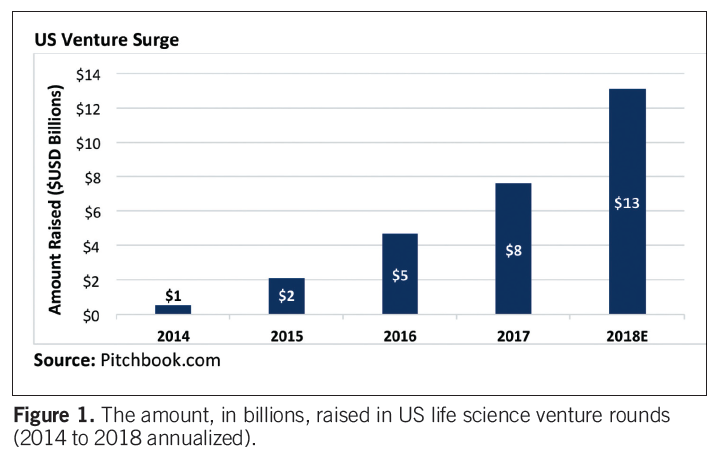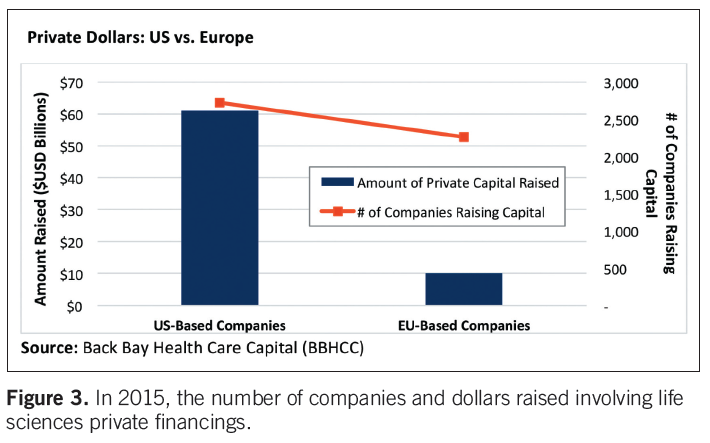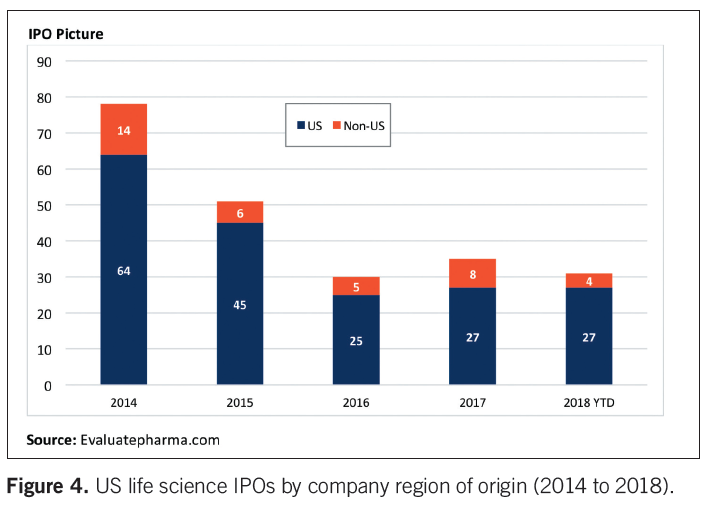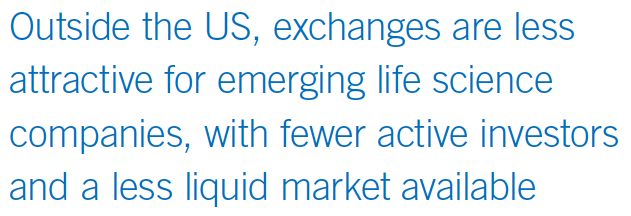Cross-Border Funding in the Life Sciences
Pharmaceutical Executive
Record capital flows across global public and private markets has opened up new channels of investment in early-stage and novel science.
Record capital flows across global public and private markets has opened up new channels of investment in early-stage and novel science
The biotechnology ecosystem has seen considerable investment over the last few years from a multitude of sources within both the private and public markets. Traditional legacy investment funds are continuing to invest heavily in the sector, with multiple well-known venture and growth equity firms raising new funds well beyond their target size and many new first-time fund entrants joining the mix. Beyond these traditional early-stage investor types, multiple prominent asset managers (i.e., Baillie Gifford, crossover funds, hedge funds, and sovereign wealth funds) have been lured into the life sciences ecosystem as a means of generating alpha after observing high profile exits from the sidelines for many years.
The US is fertile territory for identifying investable opportunities within the life sciences and a prominent target capital source for emerging companies (see Figure 1). However, there has been a considerable increase in cross-border funding activity as globalization continues at a macro level and regional interest in novel drug and device development to address both economic and social needs and broad recognition of the scientific breakthroughs occurring all over the world increases.

The private financing market is the lifeblood of the life sciences sector. In 2018, the market has already seen a record number of private venture financings, with US life science companies securing a staggering $4.7 billion in funding in the first three months alone. This level of funding is almost four times the average amount raised in the same period during 2012 and 2013. We believe this is occurring for reasons beyond merely the high number of promising life science companies that continue to emerge.
Over the last year, we observed several new investor-type entrants to the early-stage life sciences field, with public crossover investors, non-US venture funds, sovereign wealth funds, and high net worth (HNW) family offices eyeing a piece of opportunities for the first time that may turn out to lead to highly lucrative exits.
China-based VCs and HNWs have put a record amount of capital to work for US-based life science companies. Chinese VC investment into US biotech companies in the first half of the year surpassed the record set for the whole of 2017, with these funds participating in investment rounds in US biotech companies worth $5.1 billion so far (see Figure 2). We believe that these capital flows into US biotech from China will continue at a record pace. Chinese healthcare VC and PE funds raised $40 billion last year, but invested just $12 billion domestically, according to ChinaBio.

There is a significant disparity in the amount of venture funding raised by companies depending on their region of origin. In 2015, there were roughly an equivalent number of life science organizations raising capital in the US vs. the EU. However, the US financings outpaced the EU financings six to one when considering dollars raised (see Figure 3 ). This is a function of a number of factors, including:
- There is less institutional capital available to emerging life science companies in the EU.
- EU-based companies are considerably more capital efficient, often approaching financing through drip feeding rather than the buffered capital approach.
- EU-based companies take a more pragmatic and risk-averse approach to drug development (i.e., generating proof of concept in one to two target indications versus pursuing five to 10 at once).

Life science transaction advisors widely believe that truly innovative and high-quality companies will always find a way to attract the capital needed to further their R&D ambitions. In recognition of the significant regional funding gap highlighted, several EU companies are now looking to US private funding sources as a means of increasing their capital base. Additionally, EU government organizations and venture syndicates are urging sources of capital from non-EU regions to fund their companies. This cross-border funding ambition for US venture dollars extends in both directions.
As record-breaking life science focused venture funds were raised within the US, there are a high amount of dollars competing for high-quality US investment opportunities. This dynamic has lowered the cost of capital to those seeking funding and, in turn, has led to an increase in valuations during these funding rounds (i.e., venture investors are paying more money for ownership stakes than before).
The US has historically been regarded as the most attractive target for life science companies seeking to raise capital via the public equity markets. Over the last four and a half years, 225 life science firms have executed successful initial public offerings (IPOs) on the two major US exchanges, NASDAQ and NYSE (see Figure 4). We are experiencing a record number of life science IPOs, with 13 completed, raising an aggregate of $3.8 billion in capital in June alone and an additional eight actively in the queue.

Outside the US, exchanges are less attractive for emerging life science companies, with fewer active investors and a less liquid market available to support these high-risk companies. Considering this, it has not been uncommon for high-quality non-US-based companies to target a US listing. From 2014 through July 2018, 37 or 16% of all US IPOs have involved companies based outside of the US.
The inverse of the trend above (i.e., US companies seeking a listing on non-US exchanges) is by and large non-existent. From 2014 to July 2018, just six of the 166 life science IPOs that took place on non-US exchanges involved US-based companies. Of these, four of the listings targeted the London Stock Exchange (LSE), another highly regarded stock exchange that in 2014 was predicted to have a renaissance of biotech IPO listings after Circassia, a UK-based allergy company, raised $330 million in an IPO on the exchange.

These predictions have gone unfulfilled, with just 21 life science IPOs completed on the exchange over the last four and a half years. Recently, however, the Hong Kong Stock Exchange has lifted its stringent IPO listing requirements in an effort to attract more companies and open access to the vast amounts of capital in Asia. This change in policy has already created results, with Ascletis achieving a successful listing. There are reports of an additional four companies already eyeing the exchange.
Momentum and migration
It is an exciting time for the life sciences industry, with record capital flows across private and public markets attributed to a myriad of attractive, novel companies and the migration of alternative sources of capital into the field. We expect that recent cross-border funding trends, particularly China investments in US biotech, will continue to experience positive momentum as scientific breakthroughs continue to take place on a global scale and investors seek to participate in their potential success, regardless of their origin.
James Leech is a Senior Associate and Transaction Advisory Expert at Back Bay Life Science Advisors

Cell and Gene Therapy Check-in 2024
January 18th 2024Fran Gregory, VP of Emerging Therapies, Cardinal Health discusses her career, how both CAR-T therapies and personalization have been gaining momentum and what kind of progress we expect to see from them, some of the biggest hurdles facing their section of the industry, the importance of patient advocacy and so much more.
Regeneron, Roche Launch Major US Expansion Plans to Meet Growing Demand for Biologics and Innovation
April 22nd 2025With combined investments exceeding $53 billion, both companies are deepening their US presence through expanded biologics production, gene therapy capabilities, and next generation R&D centers.